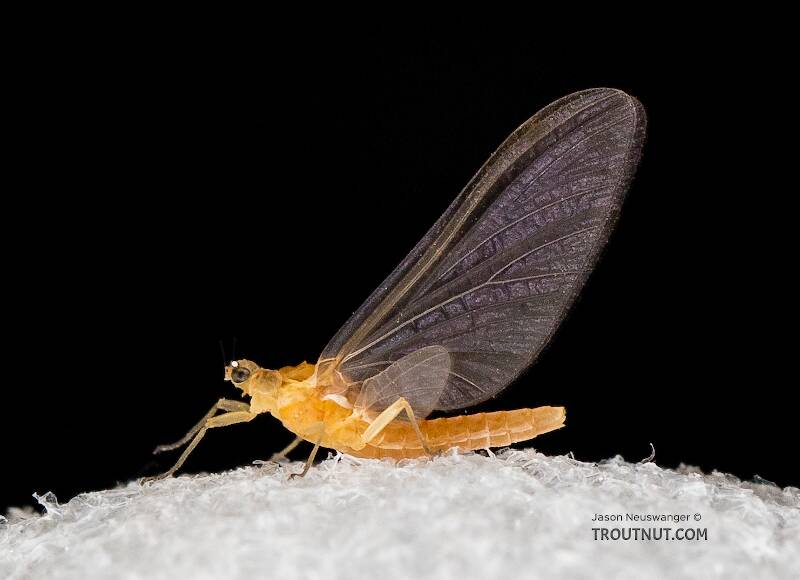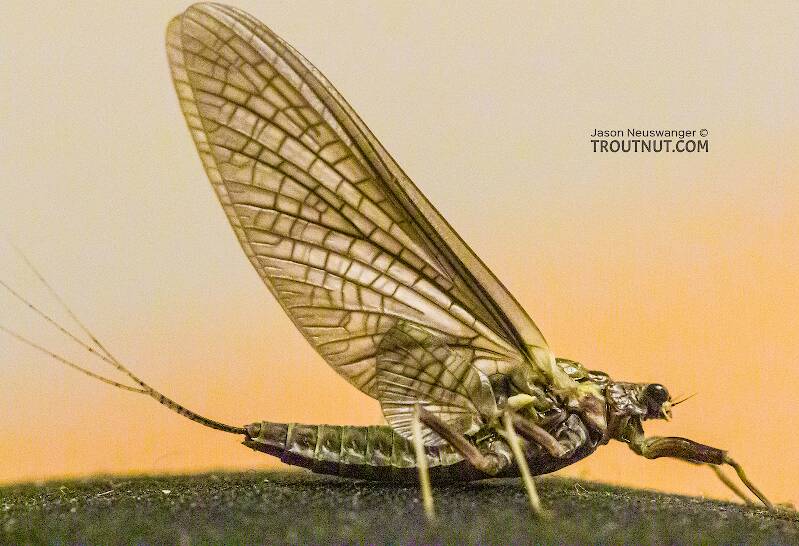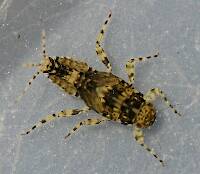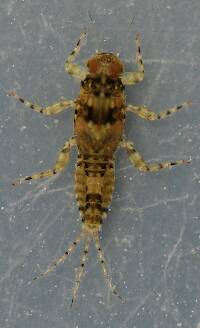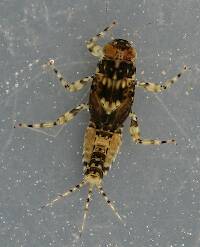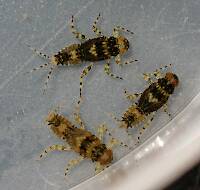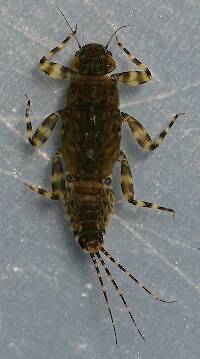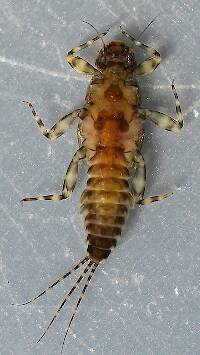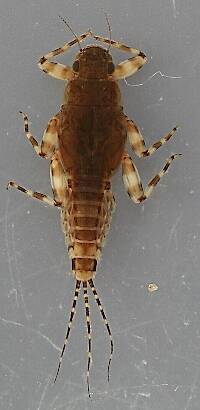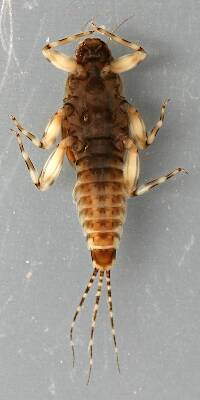
Hex Mayflies
Hexagenia limbata
The famous nocturnal Hex hatch of the Midwest (and a few other lucky locations) stirs to the surface mythically large brown trout that only touch streamers for the rest of the year.
Featured on the forum

This is the first of it's family I've seen, collected from a tiny, fishless stream in the Cascades. The three species of this genus all live in the Northwest and are predators that primarily eat stonefly nymphs Merritt R.W., Cummins, K.W., and Berg, M.B. (2019).

Troutnut is a project started in 2003 by salmonid ecologist Jason "Troutnut" Neuswanger to help anglers and
fly tyers unabashedly embrace the entomological side of the sport. Learn more about Troutnut or
support the project for an enhanced experience here.
This topic is about the Mayfly Family Ephemerellidae
The Ephemerellidae are undoubtedly the most important family of mayflies for the American trout angler. Most species known as Hendricksons, Pale Morning Duns and Sulphurs belong to the genus Ephemerella in this family, while the genus Drunella lays claim to many Eastern and Western Blue-Winged Olives and the Western Green Drakes.Example specimens
GONZO on Oct 2, 2008October 2nd, 2008, 9:52 am EDT
Some of our forum members who share my bug-geeky tendencies will be interested to know that Konchu (Luke Jacobus) has recently published a worldwide revision of the Ephemerellinae. I recently made a passing reference to his work in another thread ("changing water level"). From a fly-fishing perspective, this group includes some of our most famous and important mayflies. Most of the scientific names for famous fly-fishing hatches remain relatively unchanged (a relief for those who dislike learning new names), but there are some subtle changes and new names for a few hatches that are less famous.
Here are a few notes about species important to (North American) fly fishers:
Hendrickson (east/central)--still Ephemerella subvaria.
Large Sulphur/PED (east/central)--still Ephemerella invaria. Konchu notes that further research and clarification is needed for this species/complex (incorporating the former E. rotunda).
Small Sulphur/PED/PMD (east/west)--still Ephemerella dorothea, though (as I read it) E. infrequens is listed as a synonym rather than a subspecies. The need for further research is also indicated for this species/complex. (The other PMD, E. excrucians, is unchanged, still synonymous with E. inermis.)
Olive Morning Duns/BWOs (east)--Previously synonymized with Drunella lata, the former species cornuta and cornutella have been reinstated to full species status. The status of D. longicornus is uncertain, and more research is indicated in order to further clarify this group.
Western Green Drakes (west)--Drunella doddsii and grandis continue to be the names of the famous large WGDs, and Drunella flavilinea is unchanged for the small WGD or "Flav."
Little Black Quill/Darth Vader (east)--Not as famous as some in this group, this distinctive little black species is widespread and often important. Formerly Serratella deficiens, it is now Teloganopsis deficiens. It is the only Nearctic representative of this mostly Palearctic/Oriental genus.
Large Leggy Sulphur (east)--Although this species is not well known (and possibly not very important to fly fishers), it has been discussed on this site, and Jason has photographed it. Formerly Ephemerella septentrionalis, it is now Penelomax septentrionalis. This new genus is monotypical.
You can find a link to an overview of this revision (along with other useful/interesting info) on Konchu's website: http://mypage.iu.edu/~lmjacobu/mayfly.html
I'm sure he would be willing to answer any questions that members might have about this revision/group.
Here are a few notes about species important to (North American) fly fishers:
Hendrickson (east/central)--still Ephemerella subvaria.
Large Sulphur/PED (east/central)--still Ephemerella invaria. Konchu notes that further research and clarification is needed for this species/complex (incorporating the former E. rotunda).
Small Sulphur/PED/PMD (east/west)--still Ephemerella dorothea, though (as I read it) E. infrequens is listed as a synonym rather than a subspecies. The need for further research is also indicated for this species/complex. (The other PMD, E. excrucians, is unchanged, still synonymous with E. inermis.)
Olive Morning Duns/BWOs (east)--Previously synonymized with Drunella lata, the former species cornuta and cornutella have been reinstated to full species status. The status of D. longicornus is uncertain, and more research is indicated in order to further clarify this group.
Western Green Drakes (west)--Drunella doddsii and grandis continue to be the names of the famous large WGDs, and Drunella flavilinea is unchanged for the small WGD or "Flav."
Little Black Quill/Darth Vader (east)--Not as famous as some in this group, this distinctive little black species is widespread and often important. Formerly Serratella deficiens, it is now Teloganopsis deficiens. It is the only Nearctic representative of this mostly Palearctic/Oriental genus.
Large Leggy Sulphur (east)--Although this species is not well known (and possibly not very important to fly fishers), it has been discussed on this site, and Jason has photographed it. Formerly Ephemerella septentrionalis, it is now Penelomax septentrionalis. This new genus is monotypical.
You can find a link to an overview of this revision (along with other useful/interesting info) on Konchu's website: http://mypage.iu.edu/~lmjacobu/mayfly.html
I'm sure he would be willing to answer any questions that members might have about this revision/group.
Konchu on Oct 2, 2008October 2nd, 2008, 11:04 am EDT
Credit for revalidation of D. cornuta and D. cornutella need to go to Dave Funk, Bernard Sweeney and John Jackson, all of the Stroud Water Research Center in Avondale, Pennsylvania.
GONZO on Oct 2, 2008October 2nd, 2008, 12:06 pm EDT
Yes, and as a huge fan of those mayflies, I appreciate their research very much. But I also recognize (as they do, I'm sure) that the questions raised by your earlier research served as a stimulus for their work.
Taxon on Oct 3, 2008October 3rd, 2008, 4:36 pm EDT
Konchu-
Based on the information contained on your website, my interpretation (of taxonomic changes involving Nearctic Ephemellinae mayfly species placement) is as follows:
Previous Taxonomy ==> New Taxonomy
Drunella lata (in part) ==> Drunella cornuta
Drunella lata (in part) ==> Drunella cornutella
Drunella lata (in part) ==> Drunella longicornis (uncertain)
Ephemerella berneri ==> Tsalia berneri
(removed per Gonzo feedback)
Ephemerella septentrionalis ==> Penelomax septentrionalis
(removed per Gonzo feedback)
Serratella deficiens ==> Teloganopsis deficiens
Serratella molita (in part) ==> Serratella serratoides
Serratella teresa ==> Matriella teresa
Serratella tibialis ==> Ephemerella tibialis
Serratella velmae ==> Ephemerella velmae
Have I missed or gotten anything wrong?
Based on the information contained on your website, my interpretation (of taxonomic changes involving Nearctic Ephemellinae mayfly species placement) is as follows:
Previous Taxonomy ==> New Taxonomy
Drunella lata (in part) ==> Drunella cornuta
Drunella lata (in part) ==> Drunella cornutella
Drunella lata (in part) ==> Drunella longicornis (uncertain)
Ephemerella berneri ==> Tsalia berneri
(removed per Gonzo feedback)
Ephemerella septentrionalis ==> Penelomax septentrionalis
(removed per Gonzo feedback)
Serratella deficiens ==> Teloganopsis deficiens
Serratella molita (in part) ==> Serratella serratoides
Serratella teresa ==> Matriella teresa
Serratella tibialis ==> Ephemerella tibialis
Serratella velmae ==> Ephemerella velmae
Have I missed or gotten anything wrong?
GONZO on Oct 3, 2008October 3rd, 2008, 5:51 pm EDT
Konchu,
Could you explain how subspecies were handled in your revision? The former(?) subspecies of Ephemerella dorothea and Caudatella heterocaudata are listed differently.
I'm also curious about the E. cornuta synonym listed under the Palearctic species Serratella tsuno. Was it a homonym? I see that it has a different nominating author, but I'm not familiar with the meaning of "nec" preceding the mention of Morgan's cornuta in the same line.
Roger,
The only thing I noticed in a very cursory comparison with the Mayfly Central list was that E. consimilis and E. unicornis were already listed as nomen dubium (dub.). And I'm not sure why you include "in part" after S. molita. I don't see S. molita continuing as a valid species in the revision. Konchu's 2007 paper on the reinstatement of serratoides is available on the FAMU site. The single holotype of molita seems to have an uncertain identity, and the name is considered to be a nomen dubium.
Could you explain how subspecies were handled in your revision? The former(?) subspecies of Ephemerella dorothea and Caudatella heterocaudata are listed differently.
I'm also curious about the E. cornuta synonym listed under the Palearctic species Serratella tsuno. Was it a homonym? I see that it has a different nominating author, but I'm not familiar with the meaning of "nec" preceding the mention of Morgan's cornuta in the same line.
Roger,
The only thing I noticed in a very cursory comparison with the Mayfly Central list was that E. consimilis and E. unicornis were already listed as nomen dubium (dub.). And I'm not sure why you include "in part" after S. molita. I don't see S. molita continuing as a valid species in the revision. Konchu's 2007 paper on the reinstatement of serratoides is available on the FAMU site. The single holotype of molita seems to have an uncertain identity, and the name is considered to be a nomen dubium.
Taxon on Oct 3, 2008October 3rd, 2008, 8:18 pm EDT
Gonzo-
Good catch, thanks.
Well, there was actually some method to my madness. The baseline for taxonomic changes was Mayfly Central's North American Species List, which currently lists subject species as follows:
Serratella molita (McDunnough), 1930
* Ephemerella molita McDunnough, 1930 (orig.)
* Ephemerella serratoides McDunnough, 1931 (syn.)
* Serratella serratoides (McDunnough), 1931 (syn.)
With that in mind, my (perhaps inappropriate) use of "in part" was intended to communicate that only the part of Serratella molita, which was represented by (synonyms) Ephemerella serratoides and Ephemerella serratoides, was proposed to now have species status as Serratella serratoides, as the part of Serratella molita, which had been known by (synonym) Ephemerella molita, was now proposed to be considered as nomen dubium.
The only thing I noticed in a very cursory comparison with the Mayfly Central list was that E. consimilis and E. unicornis were already listed as nomen dubium (dub.).
Good catch, thanks.
And I'm not sure why you include "in part" after S. molita. I don't see S. molita continuing as a valid species in the revision. Konchu's 2007 paper on the reinstatement of serratoides is available on the FAMU site. The single holotype of molita seems to have an uncertain identity, and the name is considered to be a nomen dubium.
Well, there was actually some method to my madness. The baseline for taxonomic changes was Mayfly Central's North American Species List, which currently lists subject species as follows:
Serratella molita (McDunnough), 1930
* Ephemerella molita McDunnough, 1930 (orig.)
* Ephemerella serratoides McDunnough, 1931 (syn.)
* Serratella serratoides (McDunnough), 1931 (syn.)
With that in mind, my (perhaps inappropriate) use of "in part" was intended to communicate that only the part of Serratella molita, which was represented by (synonyms) Ephemerella serratoides and Ephemerella serratoides, was proposed to now have species status as Serratella serratoides, as the part of Serratella molita, which had been known by (synonym) Ephemerella molita, was now proposed to be considered as nomen dubium.
GONZO on Oct 4, 2008October 4th, 2008, 4:03 am EDT
Understood. Can you help with nec? From the context, I assume it is distinguishing between two homonyms (one that is synonymous with the listed species and one that is not), but I don't know the meaning.
GONZO on Oct 4, 2008October 4th, 2008, 5:23 am EDT
Nevermind. Apparently, nec is a Latin contraction of et non ("and not"). I get it now. (Where is Louis when I need him?) :)
Quick Reply
Related Discussions
Topic
Replies
Last Reply
10
Apr 29, 2009
by Troutnut
by Troutnut
10
Sep 12, 2010
by Martinlf
by Martinlf


